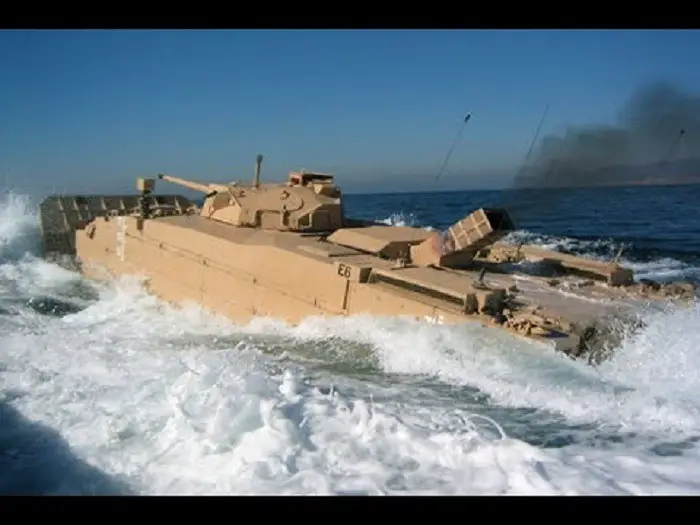The Expeditionary Fighting Vehicle (EFV) (formerly known as the Advanced Amphibious Assault Vehicle) was an amphibious assault vehicle developed by General Dynamics for use by the U.S. Marine Corps. It would have been launched at sea, from an amphibious assault ship beyond the horizon, able to transport a full Marine rifle squad to shore. It would maneuver cross country with an agility and mobility equal to or greater than the M1 Abrams.
The EFV, designed by General Dynamics Land Systems, was an amphibious armored tracked vehicle with an aluminum hull. The engine is a custom MTU Friedrichshafen diesel (MT883) with two modes of operation; a high power mode for planing over the sea, and a low power mode for land travel. It has a crew of three and can transport 17 marines and their equipment. The EFV would have been the first heavy tactical vehicle with a space frame structure.
The hull had a hydraulically actuated bow flap to aid planing with a maximum waterborne speed of 46 kilometres per hour (29 mph; 25 kn). Shrouded Honeywell waterjet propulsors are integrated into each side of the hull, which create over 2,800 horsepower of thrust. It was also outfitted with hydraulically actuated chines to cover the tracks while in seafaring mode. The vehicle uses an Ethernet network connected by the Tactical Switch Router, based on the COTS DuraMAR Mobile IP router for its internal and external communications.
The electrically powered two-man MK46 turret on the personnel variant accommodated the commander on the right and gunner on the left, a fire control system, and the main and coaxial weapons. The standard version was to have had a Mk44 Bushmaster II 30 mm cannon, which fired up to 250 rounds per minute with single, burst, and fully automatic capabilities up to 2,000 metres (2,200 yd) in all weather conditions. A general purpose M240 7.62 mm machine gun with 600 rounds of ready-to-use ammunition was to be mounted coaxially with the main gun.
The EFV was fitted with composite armor, mine-blast protection, and a nuclear, biological and chemical defense system. The aluminum hull caused some concern due to protection issues. However, aluminum hulls have been used for decades in military ground vehicles and watercraft. The EFV offers blast protection equal to a category-2 Mine Resistant Ambush Protected vehicle, including two simulated improvised explosive devices under its belly and tracks. Tests also show that it has superior protection from direct and indirect fire. The flat hull, which has endured persistent criticism for not being the more blast-resistant V-shape, was necessary for the EFV to plane across the surface of the water and reach its high speed, while dealing with sea states of Category 4.
The EFV was designed to replace the aging AAV-7A1 Assault Amphibious Vehicle (AAV), which entered service in 1972, and was the Marine Corps’ number one priority ground weapon system acquisition. It was to have had three times the speed in water and about twice the armor of the AAV, as well as superior firepower. The vehicle was to be deployed in 2015;however, on 6 January 2011, Secretary of Defense Robert Gates recommended the EFV program be canceled. The program, which was projected to cost $15 billion, had already cost $3 billion. The Marines asked for the EFV to be canceled in favor of the Assault Amphibian Vehicle Service Life Extension Program and the Marine Personnel Carrier, which itself became phase one of the Amphibious Combat Vehicle.
















